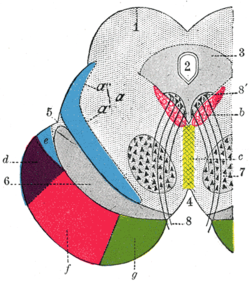- Corticopontine fibers
-
Brain: Corticopontine fibers 
Coronal section through mid-brain.
1. Corpora quadrigemina.
2. Cerebral aqueduct.
3. Central gray stratum.
4. Interpeduncular space.
5. Sulcus lateralis.
6. Substantia nigra.
7. Red nucleus of tegmentum.
8. Oculomotor nerve, with 8’, its nucleus of origin. a. Lemniscus (in blue) with a’ the medial lemniscus and a" the lateral lemniscus. b. Medial longitudinal fasciculus. c. Raphé. d. Temporopontine fibers. e. Portion of medial lemniscus, which runs to the lentiform nucleus and insula. f. Cerebrospinal fibers. g. Frontopontine fibers.Latin fibrae corticopontinae, tractus corticopontinus Gray's subject #191 862 NeuroNames ancil-375 Corticopontine fibers are projections from the cerebral cortex to the pontine nuclei.[1]
Depending upon the lobe of origin, they can be classified as frontopontine fibers, parietopontine fibers, temporopontine fibers and occipitopontine fibers.[2]
They are motor fibers that stretch from the precentral gyrus (motor strip) to the nuclei of cranial nerves V (trigeminal), VII (facial) and XII (hypoglossal). These fibers run alongside the corticospinal fibers.
Clinical significance
Several clinical phenomena result from injury to the corticopontine fibers. The corticopontine fibers to cranial nerves V and XII descend to bilateral nuclei. Injury to these fibers result in tongue weakness (cranial nerve XII) and jaw weakness (cranial nerve V) but not full paralysis. The corticopontine fibers to cranial nerve VII descend to innervate bilateral sub-nuclei that supply the forehead but only contralateral to the sub-nuclei that supply the lower face. Injury to these fibers results in paralysis of the lower face, but only weakness of the forehead.
References
- ^ Leergaard TB, Bjaalie JG (November 2007). "Topography of the complete corticopontine projection: From experiments to principal Maps". Front Neurosci 1 (1): 211–23. doi:10.3389/neuro.01.1.1.016.2007. PMC 2518056. PMID 18982130. http://www.pubmedcentral.nih.gov/articlerender.fcgi?tool=pmcentrez&artid=2518056.
- ^ http://braininfo.rprc.washington.edu/AncilDefinition.aspx?ID=1322&questID=1322
External links
- Brainstem at UWisc 16Pontine
Human brain, rhombencephalon, metencephalon: pons (TA A14.1.05.101–604, GA 9.785) Dorsal/
(tegmentum)SurfaceWhite: Sensory/ascendingTrapezoid body/VIII · Trigeminal lemniscus (Dorsal trigeminal tract, Ventral trigeminal tract) · Medial lemniscus · Lateral lemniscus
MLF, III, IV and VI: Vestibulo-oculomotor fibers
Anterior trigeminothalamic tract · Central tegmental tractWhite: Motor/descendingICP (Vestibulocerebellar tract)
MLF, III, IV and VI: Vestibulospinal tract (Medial vestibulospinal tract, Lateral vestibulospinal tract)Other greyVentral/
(base)White: Motor/descendingSurfaceBasilar sulcusOther grey: Raphe/
reticularHuman brain: mesencephalon (midbrain) (TA A14.1.06, GA 9.800) Tectum
(Dorsal)SurfaceWhite: Sensory/ascendingWhite: Motor/descendingPeduncle
(Ventral)White: Sensory/ascendinglemnisci (Medial, Lateral) · Ascending MLF (Vestibulo-oculomotor fibers) · Spinothalamic tract · Anterior trigeminothalamic tract · Dentatothalamic tractWhite: Motor/descendingGrey: otherPeriaqueductal gray/Raphe nuclei (Dorsal raphe nucleus)
Ventral tegmental area • Pedunculopontine nucleus • Red nucleus
riMLFBaseWhite: Motor/descendingCerebral crus: Corticospinal tract · Corticobulbar tract · Corticopontine tract/Frontopontine fibers/Temporopontine fibersSurfaceCategories:- Neuroanatomy
- Neuroanatomy stubs
Wikimedia Foundation. 2010.
